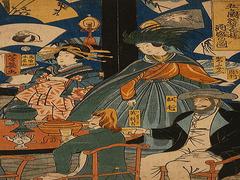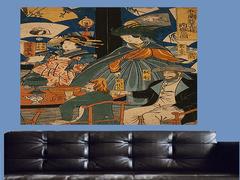The Ukiyo-e art movement stands as a beacon of artistic innovation and cultural expression during the Edo period (1603-1868) in Japan. Renowned for its stunning woodblock prints that captured the essence of daily life, landscapes, and the world of entertainment, Ukiyo-e remains a testament to the creativity and craftsmanship of its time. This article delves into the Ukiyo-e Renaissance, a period of artistic flourishing that produced some of the most iconic prints in Japanese history.
The Urban Aesthetic
The term "ukiyo-e" translates to "pictures of the floating world," a phrase that encapsulates the movement's focus on the transient and fleeting aspects of life. Edo, now Tokyo, was the center of this cultural phenomenon, a bustling metropolis where merchants, artists, and the emerging urban class sought respite from the rigid social structure of the samurai-dominated society. Ukiyo-e prints depicted the pleasures of urban life, from the bustling markets to the tranquil gardens, creating a visual diary of the city's evolving identity.
The Prolific Artists
The Ukiyo-e Renaissance saw the rise of numerous gifted artists who transformed woodblock printing into a refined and respected art form. Utagawa Hiroshige, a master of landscapes, produced the iconic "One Hundred Famous Views of Edo," a series that showcased the changing seasons and atmospheric moods of the city. Katsushika Hokusai, another luminary of the movement, created his seminal series "Thirty-Six Views of Mount Fuji," which includes the universally recognized "The Great Wave off Kanagawa."
The Process of Creation
Woodblock printing was a collaborative endeavor that required the expertise of various artisans. An artist would first create a design, often on paper, which was then handed over to a skilled woodblock carver. The carver meticulously carved separate blocks for each color, ensuring precise registration. These blocks were inked and pressed onto paper, resulting in multicolored and highly detailed prints. The intricate process allowed for the replication of images, making art accessible to a broader audience.
Themes and Subjects
Ukiyo-e prints covered a wide array of subjects, from landscapes and seascapes to kabuki actors, sumo wrestlers, and beautiful courtesans. Scenes from popular stories, historical events, and mythology were also common themes. The prints not only offered visual delight but also served as windows into the cultural values, societal norms, and the entertainment tastes of the time.
Global Impact: Japonisme
As the 19th century unfolded, Japan gradually opened its doors to the world, and Western audiences became enamored with its unique artistic heritage. The influence of Ukiyo-e, particularly its flat compositions, bold lines, and vibrant colors, led to the Japonisme movement in Europe. The works of Van Gogh, Monet, and others bear the indelible mark of Ukiyo-e, underscoring its enduring cross-cultural impact.
Legacy and Preservation
Despite the challenges posed by the passage of time, many Ukiyo-e prints have been preserved in museums and private collections around the world. These prints continue to inspire contemporary artists, scholars, and enthusiasts. The intricate craftsmanship, attention to detail, and evocative themes of Ukiyo-e prints resonate with modern sensibilities, reminding us of the timeless connection between art and the human experience.
Conclusion
The Ukiyo-e Renaissance was a pinnacle of artistic achievement, a period that produced masterpieces capturing the essence of an era and a society in flux. Through Ukiyo-e, artists transformed wood and ink into captivating windows that provide a glimpse into a world of beauty, aspiration, and human connection. As we admire these prints, we pay homage to an artistic legacy that continues to resonate and captivate, inviting us to explore the enchanting landscapes of the floating world.
- Beyond Ukiyo-e: The Diverse Landscape of Japanese Woodblock Art
- Evolution of Japanese Woodblock Printing: Tracing the Roots of an Artistic Tradition
- From Edo to the World: How Japanese Woodblock Prints Shaped Western Art and Culture
- Japanese Woodblock History
- Masters of the Blade and Block: The Collaborative Artistry of Samurai and Woodblock Printmakers
- Resilience and Reinvention: Japanese Woodblock Printing in the Face of Modernization
- Techniques and Traditions: Unraveling the Intricacies of Japanese Woodblock Printmaking
- The Influence of Nature in Japanese Woodblock Prints: Depicting Seasons and Symbolism
- The Societal Mirror: Reflecting Daily Life in Edo Period Woodblock Prints
- The Woodblock Artisans of Edo: Masters of Craftsmanship and Creativity
- Ukiyo-e Renaissance: Exploring the Golden Age of Japanese Woodblock Prints




